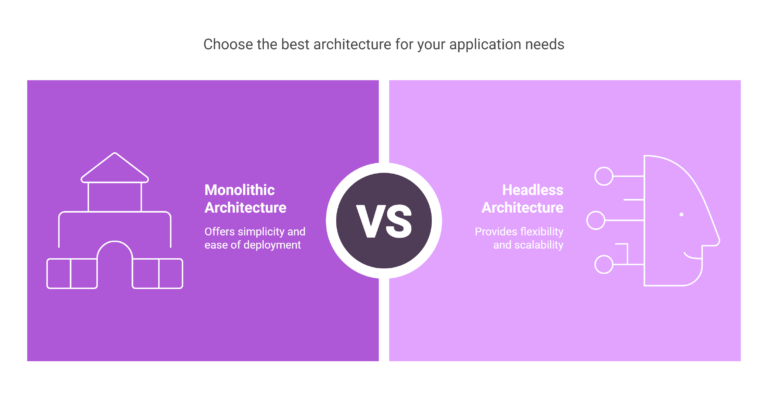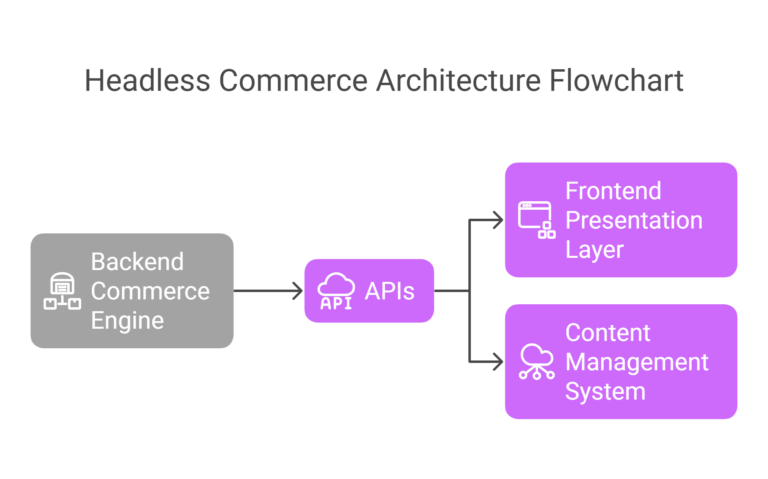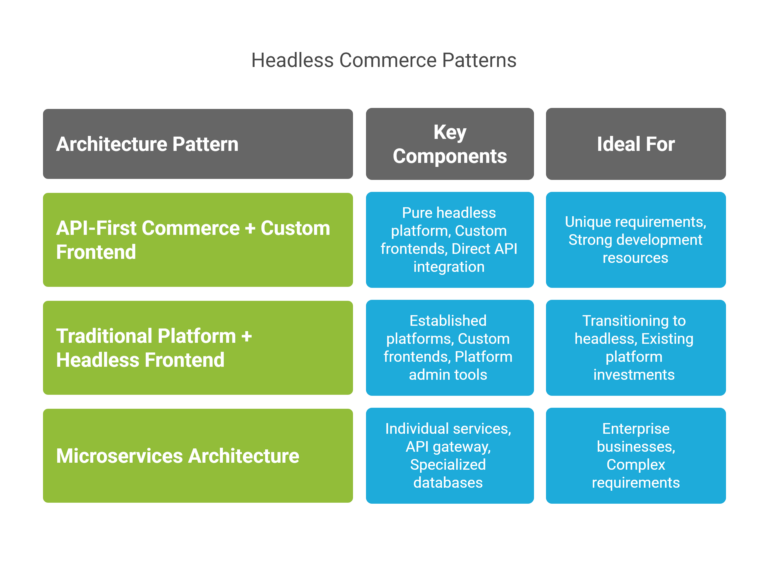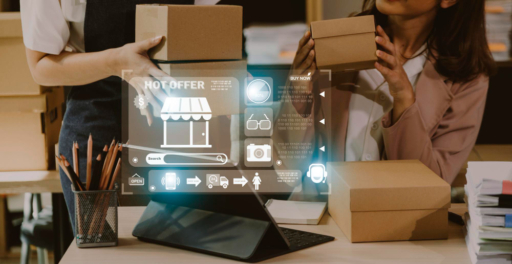Greetings! I'm Aneesh Sreedharan, CEO of 2Hats Logic Solutions. At 2Hats Logic Solutions, we are dedicated to providing technical expertise and resolving your concerns in the world of technology. Our blog page serves as a resource where we share insights and experiences, offering valuable perspectives on your queries.
QUICK SUMMARY
Headless commerce architecture separates your customer-facing experiences from your backend commerce systems, connecting them through APIs. This approach offers greater flexibility, improved performance, and better future-proofing compared to traditional monolithic systems. While it comes with increased complexity and potentially higher initial costs, the long-term benefits make it increasingly popular for forward-thinking e-commerce businesses.
Are you curious about how modern e-commerce sites deliver those lightning-fast, seamless shopping experiences across devices? Behind many of today’s most innovative online stores lies a powerful approach called headless commerce architecture.
At 2HatsLogic, we’ve helped numerous businesses understand and implement this technology and today, we’re breaking it down for you.
Let’s explore what headless commerce architecture really means, how it works, and why it might be the future of online selling.
What Is Headless Commerce Architecture?
Headless commerce architecture refers to the separation of the frontend presentation layer (what customers see and interact with) from the backend e-commerce functionality (product management, checkout processes, payment systems, etc.).

In traditional e-commerce systems, the frontend and backend are tightly coupled in a monolithic structure. Any change to the customer-facing side requires modifications to the backend, making updates slow and complicated.
Headless architecture breaks this dependency by connecting these separate systems through APIs (Application Programming Interfaces), essentially creating a flexible, modular approach to e-commerce.
The Core Components of Headless Commerce Architecture
Understanding headless commerce requires familiarity with its key components:

1. Backend Commerce Engine
This is the “body” of your headless commerce system, handling:
- Product and inventory management
- Pricing and promotions
- Order processing
- Payment gateway integration
- Customer data management
Popular examples include Commercetools, BigCommerce, and Shopify Plus.
2. APIs (The Connective Tissue)
APIs act as messengers between your frontend and backend systems:
- REST APIs: Standard web APIs that are widely supported
- GraphQL APIs: More flexible APIs that allow precise data requests
- Webhook APIs: Event-triggered APIs that enable real-time updates
3. Frontend Presentation Layer
This is the “head” that customers actually interact with:
- Web storefronts (often built with React, Vue, or Angular)
- Mobile applications
- IoT devices
- Social commerce interfaces
- Kiosks and in-store digital experiences
4. Content Management System (CMS)
Many headless implementations include a dedicated CMS for:
- Product descriptions and marketing content
- Blog posts and educational material
- Media asset management
- Content workflow and governance
Popular headless CMS options include WordPress, Contentful, Sanity, and Strapi.
How Headless Commerce Architecture Works
Let’s walk through a typical customer journey in a headless commerce system:
- Customer visits your online store
- The frontend (built with React, for example) makes an API call to the CMS to retrieve product information and marketing content
- Customer browses products
- Frontend makes API calls to the commerce engine to get real-time inventory, pricing, and product details
- Customer adds items to cart
- Cart data is stored either locally or via the commerce engine through API calls
- Customer checks out
- Frontend collects shipping and payment information
- API calls validate information and process the order in the backend
- Confirmation is returned via API to the frontend
This decoupled approach means each step can be optimized independently without affecting the entire system.
Pro Tip: When planning a headless commerce architecture, map out your customer journeys first, then identify the specific API calls required at each step. This exercise reveals potential bottlenecks and opportunities for optimization before implementation begins.
Advantages of Headless Commerce Architecture
Headless architecture offers several compelling benefits for growing e-commerce businesses:
1. Unparalleled Flexibility
With headless, you can:
- Deploy different frontend experiences for different channels
- Update your customer-facing experience without touching backend systems
- Add new sales channels without rebuilding your entire platform
2. Improved Performance
Headless typically delivers:
- Faster page load times (critical for SEO and conversion rates)
- Reduced server load through edge caching
- Better mobile experiences through purpose-built interfaces
3. Enhanced Developer Experience
Your technical team benefits from:
- Freedom to use modern frontend frameworks
- Parallel development workflows (frontend and backend teams can work simultaneously)
- Easier integration with best-of-breed services
4. Future-Proofing
As technology evolves, headless architecture allows you to:
- Adopt new frontend technologies without backend migrations
- Integrate emerging sales channels as they gain popularity
- Scale individual components based on specific needs
Want to see how these advantages would apply to your specific business?
Challenges of Headless Commerce Architecture
While powerful, headless commerce isn’t without its challenges:
1. Increased Complexity
Implementing headless commerce typically requires managing multiple systems rather than a single platform. This increased complexity demands stronger technical governance and clear ownership of different components.
Pro Tip: Before pursuing headless, ensure your team has the capacity to manage this additional complexity or has reliable partners to help.
2. Higher Initial Investment
Headless implementations often require:
- More development resources upfront
- Additional hosting and infrastructure costs
- Expertise across multiple technologies
3. Content Management Challenges
Traditional content editing workflows can be disrupted:
- Preview functionality may require custom development
- Content editors need training on new systems
- Page building can be more complex initially
4. Potential Performance Trade-offs
If not implemented properly, API calls can introduce:
- Latency issues
- Increased server costs
- Complex caching requirements
Are your developers spending more time fighting your e-commerce platform than building new features?
Common Headless Commerce Architecture Patterns
Several architectural patterns have emerged in the headless commerce space:

1. API-First Commerce + Custom Frontend
This approach combines:
- A pure headless commerce platform (like Commercetools)
- Custom-built frontends for different channels
- Direct API integration between layers
Ideal for: Businesses with unique requirements and strong development resources.
2. Traditional Platform + Headless Frontend
This hybrid approach uses:
- Established e-commerce platforms with API capabilities (Shopify Plus, Magento)
- Custom frontend experiences that connect via APIs
- Platform admin tools for merchants
Ideal for: Businesses transitioning to headless or with existing platform investments.
3. Microservices Architecture
The most modular approach includes:
- Individual services for specific functions (cart, checkout, search)
- API gateway to manage communication
- Multiple specialized databases
Ideal for: Enterprise businesses with complex requirements and large development teams.
Technology Stack Considerations
When planning a headless commerce architecture, you’ll need to make decisions about:
1. Commerce Engine
Popular options include:
- Commercetools: Truly API-first, highly flexible
- BigCommerce: Strong API capabilities with merchant-friendly tools
- Shopify Plus: Familiar admin with growing headless capabilities
- Elastic Path: Enterprise-focused, microservices approach
2. Frontend Technologies
Common choices include:
- React/Next.js: Powerful, widely-adopted JavaScript framework
- Vue/Nuxt.js: Developer-friendly alternative
- Progressive Web Apps (PWA): For mobile-optimized experiences
- Native Mobile Apps: For iOS and Android experiences
3. Content Management
Leading headless CMS options:
- WordPress (with headless setup): Popular and flexible with a vast plugin ecosystem
- Sanity: Developer-friendly, highly customizable
- Prismic: User-friendly interface with strong visual editing
- Strapi: Open-source option with good community support
Warning: Before committing to specific technologies, clearly define your business goals, required customer experiences, and operational constraints. The most impressive technology stack will fail if it doesn’t align with your actual business needs.
Getting Started with Headless Commerce Architecture
If you’re considering headless commerce for your business, here’s a practical roadmap:
Phase 1: Assessment & Strategy
- Audit your current commerce capabilities
- Identify specific limitations and pain points
- Document current integrations and workflows
- Define clear business objectives
- Priority channels and customer experiences
- Performance targets and KPIs
- Budget and timeline constraints
- Evaluate potential architectures
- Full headless vs. hybrid approaches
- Build vs. buy decisions for key components
Phase 2: Proof of Concept
- Select a limited scope
- Single product category or customer segment
- Specific frontend experience (e.g., mobile)
- Build a minimum viable implementation
- Core API integrations
- Essential customer journeys
- Key performance monitoring
- Test and learn
- Validate technical assumptions
- Gather user feedback
- Measure performance impact
Phase 3: Scaling Implementation
- Refine the architecture based on the proof of concept
- Optimize API patterns
- Address performance bottlenecks
- Enhance developer workflows
- Implement in phases
- Prioritize high-impact areas
- Maintain parallel systems during transition
- Migrate data and functionality incrementally
- Build operational capabilities
- Train content and marketing teams
- Establish monitoring and support processes
- Document architecture and governance
Pro Tip: Create a dedicated “headless transition team” with representatives from technical, marketing, and operations departments. This cross-functional approach ensures all perspectives are considered throughout implementation and helps prevent siloed decision-making.
The Future of Headless Commerce Architecture
The headless commerce landscape continues to evolve rapidly. Key trends to watch include:
- Composable Commerce: The next evolution of headless, focusing on modular business capabilities rather than just technical separation
- AI-Enhanced Experiences: Leveraging the flexibility of headless to incorporate advanced personalization and predictive capabilities
- No-Code Tooling: Emerging tools that make headless more accessible to merchants with limited technical resources
- Edge Computing Integration: Moving commerce functionality closer to users through distributed computing approaches
As these trends mature, headless architecture will likely become even more accessible and powerful for businesses of all sizes.
Explore Your Headless Commerce Options
Curious about whether headless commerce architecture could benefit your business? At 2HatsLogic, we’ve helped companies of all sizes evaluate, implement, and optimize their headless commerce strategies.
Ready to learn more about how headless commerce might fit your specific business needs? Take Our Headless Readiness Assessment to receive personalized insights based on your current situation and goals.
Let 2Hats Logic guide your headless commerce transformation.
FAQ
Is headless commerce architecture only for large enterprises?
No. While enterprise companies were early adopters, headless solutions are increasingly accessible to mid-market businesses. Modern platforms offer various entry points based on your specific needs and resources.
How much development expertise do we need in-house?
This depends on your implementation approach. Hybrid solutions with pre-built components require less technical expertise than fully custom implementations. Many businesses partner with specialized agencies (like 2HatsLogic) to complement their internal teams.
Can we migrate to headless incrementally?
Absolutely. In fact, a phased approach is often recommended. Many businesses start with a specific channel (like mobile) or section of their site before expanding to a full headless implementation.
How does headless commerce architecture impact SEO?
When implemented properly, headless can significantly improve SEO through faster page loads, better mobile experiences, and more control over metadata and structured data. However, proper implementation of SSR (Server-Side Rendering) or SSG (Static Site Generation) is crucial for search engine visibility.
What happens to our existing content in a headless migration?
Content migration is an important consideration in any headless project. Most implementations include a structured migration process to transfer and transform content from your existing platform to your new headless CMS.
Table of contents
- What Is Headless Commerce Architecture?
- The Core Components of Headless Commerce Architecture
- How Headless Commerce Architecture Works
- Advantages of Headless Commerce Architecture
- Challenges of Headless Commerce Architecture
- Common Headless Commerce Architecture Patterns
- Technology Stack Considerations
- Getting Started with Headless Commerce Architecture
- The Future of Headless Commerce Architecture
- Explore Your Headless Commerce Options

Related Articles







